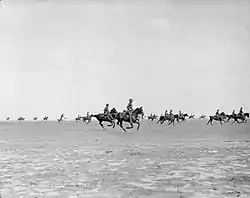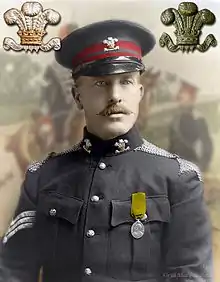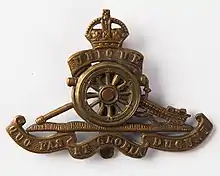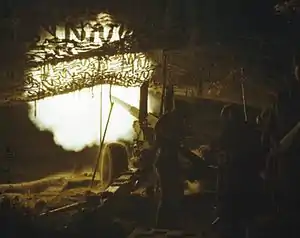Denbighshire Hussars
The Denbighshire Hussars was a Welsh Yeomanry regiment of the British Army formed in 1794. It saw service in the First World War before being converted into a unit of the Royal Artillery. The lineage has been continued by 398 (Flint & Denbighshire Yeomanry) Squadron, Royal Logistic Corps.
| Denbighshire Hussars | |
|---|---|
| Active | 1794 – Present |
| Country | |
| Branch | |
| Type | Yeomanry |
| Role | Yeomanry Cavalry Infantry Bicycle infantry Medium artillery |
| Size | Up to three Regiments |
| Engagements | Second Boer War First World War |
| Battle honours | See battle honours below |
French Revolutionary and Napoleonic Wars
After Britain was drawn into the French Revolutionary Wars, the government of Prime Minister William Pitt the Younger proposed on 14 March 1794 that the counties should form Corps of Yeomanry Cavalry that could be called on by the King to defend the country against invasion or by the Lord Lieutenant to subdue any civil disorder within the county.[1] A Troop of Gentlemen and Yeoman of Wrexham was formed on 23 May 1795 at Wrexham, a rapidly growing industrial town in Denbighshire, North Wales. Another Troop was raised at Denbigh in 1799. In 1803, when the short-lived Peace of Amiens broke down and the Napoleonic Wars began, two more Troops were raised and the force became a regiment as the Wrexham Yeomanry Cavalry.[2][3][4]
19th Century
By 26 January 1820, when the regiment became the Denbighshire Yeomanry Cavalry, there were five Troops. When Government support of the Yeomanry was withdrawn in 1828 the regiment carried on without pay until 1831 when pay for drills and periods of service was restored.[2][3] Although the Yeomanry generally declined in importance and numbers after the end of the French wars,[5] the Denbigh regiment was sometimes called out to suppress riots. It was used to quell a disturbance by colliery workers in Rhosllannerchrugog in 1830: the colliery workers were angered by the truck shop system that forced them to spend their wages in shops owned by their employers and planned to destroy a truck shop owned by the British Ironworks Company. The Regiment was ordered out on patrol to 'terrify the mob.'[4] At an incident in Rhosllannerchrugog, known as the Battle of Cinder Hill, overzealous troops had to be brought under control after a demonstrator threw a firework at the soldiers.[4]
In the 1860s, most of the regiment's officers were former officers in the 1st or 2nd Life Guards, led by the commanding officer (CO), Lieutenant-Colonel Charles John Tottenham of Plas Berwyn, Denbighshire, (late of the 2nd LG and High Sheriff of Denbighshire) who was appointed to the command on 12 June 1857. He was simultaneously CO of the Royal Merioneth Militia. He held the Yeomanry command until he retired and became the regiment's Honorary Colonel on 30 May 1874.[6][7] He was succeeded as CO by Lt-Col Tom Naylor-Leyland of Nantclwyd Hall, Ruthin (also late of the 2nd LG).[6][8][9] The regimental headquarters was at Llangollen, moving to Ruthin in the 1870s.[6]
The Regiment became the Denbighshire (Hussars) Yeomanry Cavalry in 1876.[2][6]
Imperial Yeomanry

The Yeomanry was not intended to serve overseas, but following a string of defeats during Black Week in early December 1899, the British government realised that it would need more troops than just the regular army to fight the Second Boer War, particularly mounted troops. On 13 December, the War Office decided to allow volunteer forces to serve in the field, and a Royal Warrant was issued on 24 December that officially created the Imperial Yeomanry (IY). The Royal Warrant asked standing Yeomanry regiments to provide service companies of approximately 115 men each. In addition to this, many British citizens (usually mid-upper class) volunteered to join the new force.[10][11][12][13]
The Denbighshire Hussars raised the 29th (Denbighshire) Company for the IY, which arrived in South Africa on 5 March 1900 and served in 9th Battalion, IY.[2][13][14][15][16] The company served until 1901, earning the regiment its first Battle honour: South Africa 1900–01.[2][6][17]

The Imperial Yeomanry were trained and equipped as mounted infantry. The concept was considered a success and before the war ended the existing Yeomanry regiments at home were converted into Imperial Yeomanry, with an establishment of HQ and four squadrons with a machine gun section. This included the Denbighshire Hussars, now the Denbighshire Imperial Yeomanry.[2][6]
In the early 1900s the regiment's C Squadron recruited in neighbouring Caernarvonshire and included a Troop from Anglesey, while D Squadron recruited in neighbouring Cheshire.[2][18]
A.G. Edwards, Bishop of St Asaph, was appointed the regiment's Honorary Chaplain in 1902, attaining the rank of Chaplain 1st Class (TF) in 1906. [6][19]
Territorial Force
| Welsh Border Mounted Brigade |
|---|
|
Organisation on 4 August 1914 |
|
The Imperial Yeomanry were subsumed into the new Territorial Force (TF) under the Haldane Reforms of 1908.[20][21][22] and the regiment was officially titled the Denbighshire Yeomanry (Hussars) with the following organisation:[2][6]
- A Squadron at Wrexham, with detachments at Market Street, Llangollen,[23] Earl Street, Mold, Flintshire[24] and Ruabon
- B Squadron at Love Lane, Denbigh,[25] with detachments at Prestatyn,[26] John Street, Rhyl,[27][28] and Denbigh Road, Ruthin[23][29]
- C Squadron at Glynne Road, Bangor,[30][31] with detachments at Caernarvon, Argyll Road, Llandudno[31][32] and Beaumaris
- D Squadron at 24 Clifon Road, Tranmere, Birkenhead, Cheshire[33]
In 1911 the Regiment had the honour of being the escort to the Prince of Wales to his Investiture at Caernarfon Castle.[4] In 1913 the regiment moved its headquarters to Hightown Barracks in Wrexham where it remained throughout the First World War.[4][2][6]
First World War
In accordance with the Territorial and Reserve Forces Act 1907 (7 Edw. 7, c.9) which brought the Territorial Force into being, the TF was intended to be a home defence force for service during wartime and members could not be compelled to serve outside the country. However, on the outbreak of war on 4 August 1914, many members volunteered for Imperial Service. Therefore, TF units were split in August and September 1914 into 1st Line (liable for overseas service) and 2nd Line (home service for those unable or unwilling to serve overseas) units. Later, a 3rd Line was formed to act as a reserve, providing trained replacements for the 1st and 2nd Line regiments.[34]
1/1st Denbighshire Hussars
The 1/1st Denbighshire Hussars was mobilised with the Welsh Border Mounted Brigade on 4 August 1914 at the outbreak of the First World War. It moved to East Anglia where it joined the 1st Mounted Division in September 1914.[35] In November 1915, the brigade was dismounted.[36]
The regiment was posted with the brigade to Egypt in March 1916. On 20 March, Welsh Border Mounted Brigade was absorbed into the 4th Dismounted Brigade (along with the South Wales Mounted Brigade).[37]
The brigade was with the Suez Canal Defences when, on 14 January 1917, Egyptian Expeditionary Force (EEF) Order No. 26 instructed that the 2nd, 3rd and 4th Dismounted Brigades be reorganized as the 229th, 230th and 231st Brigades.[38]
Between January and March 1917 the small Yeomanry regiments were amalgamated and numbered as battalions of infantry regiments recruiting from the same districts.[lower-alpha 1] As a result, the 1/1st Denbighshire Hussars was converted to 24th (Denbighshire Yeomanry) Battalion, Royal Welch Fusiliers (24th RWF) in February 1917.[40][41]
On 23 February, the General Officer Commanding the EEF, Lieutenant-General Sir A.J. Murray, sought permission from the War Office to form the 229th, 230th and 231st Brigades into a new division. On 25 February, the War Office granted permission and the new 74th (Yeomanry) Division started to form. The 231st Brigade joined the division at el Arish by 9 March.[38]
It took part in the invasion of Palestine in 1917 and 1918, including the Second (17–19 April 1917) and Third Battles of Gaza (27 October–7 November) – including the capture of Beersheba on 31 October and the Sheria Position on 6 November. At the end of 1917, it took part in the capture and defence of Jerusalem and in March 1918 in the Battle of Tell 'Asur. On 3 April 1918, the division was warned that it would move to France and by 30 April 1918 had completed embarkation at Alexandria.[38]
In May 1918, the battalion landed at Marseilles, France with 74th (Yeomanry) Division. Due to a lack of replacements, British[lower-alpha 2] infantry divisions on the Western Front had been reduced from 12 to nine battalions in January and February 1918.[42] To conform with this new structure, on 21 June, 12th (Ayrshire and Lanarkshire Yeomanry) Battalion, Royal Scots Fusiliers (of 229th Brigade), 12th (Norfolk Yeomanry) Battalion, Norfolk Regiment (of 230th Brigade) and 24th RWF left the 74th (Yeomanry) Division.[43] They were used to reconstitute 94th Brigade of 31st Division which was renamed the 94th (Yeomanry) Brigade on that date.[44]
It remained with the 94th (Yeomanry) Brigade, 31st Division for the rest of the war, taking part in the latter part of the Battle of the Lys (Le Becque, 28 June), the Capture of Vieux-Berquin (13 August) and the Final Advance in Flanders (Fifth Battle of Ypres, 28 September – 2 October).[45] By the Armistice of 11 November 1918, the battalion was in Belgium, moving from Avelghem to Renaix.[46]
2/1st Denbighshire Hussars
The 2nd Line regiment was formed in 1914 and joined the 2/1st Welsh Border Mounted Brigade in the Newcastle area of Northumberland in January 1915[47] (along with the 2/1st Shropshire Yeomanry[48] and the 2/1st Cheshire Yeomanry[47]). The brigade was placed under the command of the 63rd (2nd Northumbrian) Division.[49] On 31 March 1916, the remaining Mounted Brigades were ordered to be numbered in a single sequence and the brigade became 17th Mounted Brigade, still in Northumberland under Northern Command.[37]
In April 1916, it moved with its brigade to East Anglia where it joined the 1st Mounted Division; it replaced its 1st Line which had departed (dismounted) for Egypt.[36] By July it had left with its brigade for the Morpeth, Northumberland area.[47]
In July 1916 there was a major reorganization of 2nd Line yeomanry units in the United Kingdom. All but 12 regiments were converted to cyclists[37] and as a consequence the regiment was dismounted and the brigade converted to 10th Cyclist Brigade. Further reorganization in October and November 1916 saw the brigade redesignated as 6th Cyclist Brigade in November, still in the Morpeth area.[50] At this time the regiment departed for the 1st Cyclist Brigade at Beccles in Suffolk where it was amalgamated with the 2/1st Montgomeryshire Yeomanry as the 3rd (Denbigh and Montgomery) Yeomanry Cyclist Battalion.{{efn|James also names the combined unit as 3rd (Denbigh and Montgomery) Yeomanry Cyclist Battalion[51] which seems more plausible than 3rd (Montgomery and Denbigh Yeomanry) Cyclist Battalion given that the Denbighshire Hussars were ranked 16th in the Yeomanry order of precedence whereas the Montgomeryshire Yeomanry were ranked 35th.[52] The regiment resumed its separate identity as 2/1st Denbighshire Hussars in March 1917. It moved to Worlingham (near Beccles) in July, to Aldeburgh in January 1918 and back to Worlingham in April. It was still in 1st Cyclist Brigade at the end of the war.[47]
3/1st Denbighshire Hussars
The 3rd Line regiment was formed in 1915 and in the summer it was affiliated to a Reserve Cavalry Regiment at The Curragh. In the summer of 1916 it was dismounted and attached to the 3rd Line Groups of the 55th (West Lancashire) Division as its 1st Line was serving as infantry. The regiment was disbanded early in 1917 with personnel transferring to the 2nd Line regiment or to the 4th (Reserve) Battalion of the Royal Welsh Fusiliers at Oswestry.[47]
Between the wars

Postwar, a commission was set up to consider the shape of the Territorial Force (Territorial Army from 1 October 1921). The experience of the First World War made it clear that there were too many mounted units. The commission decided that only the 14 most senior regiments were to be retained as cavalry (though the Lovat Scouts and the Scottish Horse were also to remain mounted as "scouts"). Eight regiments were converted to Armoured Car Companies of the Royal Tank Corps (RTC), one was reduced to a battery in another regiment, one was absorbed into a local infantry battalion, one became a signals regiment and two were disbanded. The remaining 25 regiments were converted to brigades[lower-alpha 3] of the Royal Field Artillery between 1920 and 1922.[55]
The Denbighshire Yeomanry was one of the regiments converted to artillery; it was re-roled as a medium artillery formation, and amalgamated with the 61st Medium Brigade Royal Garrison Artillery (the former 1st Carnarvonshire Artillery Volunteers), to form 61 Medium Regiment, RA, (Caernarvon and Denbigh Yeomanry), with the following organisation:[2][6][56][57][58]
- HQ at Colwyn Bay
- 241 (Carnarvon) Battery at Bangor, from 61st Medium Bde
- 242 (Carnarvon) Battery at Llandudno, from Denbighshire Yeomanry
- 243 (Denbigh) Battery at Colwyn Bay, from Denbighshire Yeomanry
- 244 (Denbigh) Battery at Wrexham, from Denbighshire Yeomanry
The Royal Garrison Artillery was subsumed into the Royal Artillery (RA) in 1924, and the RA adopted the term 'regiment' in place of 'brigade' in 1938.[2][6][56]
Second World War

61st (Caernarvon & Denbigh Yeomanry) Medium Regiment, RA
61st Medium Regiment saw service in France during the phoney war (1939–1940); after the Dunkirk evacuation, it would remain in the United Kingdom until returning to Europe in June 1944 with 21st Army Group.[59]
69th (Caernarvon & Denbigh Yeomanry) Medium Regiment, RA
In 1939, 61st Medium Regiment formed a duplicate unit, 69th Medium Regiment, RA which in February 1942 was designated as 69th (Caernarvon & Denbigh Yeomanry) Medium Regiment, RA.[60] It also saw service with the BEF in 1940, before being sent to North Africa in 1942, where it took part in the Battle of El Alamein. It joined the 2nd Army Group Royal Artillery and took part in the Italian Campaign from 1943 to 1945. It ended the war in North-West Europe with the 2nd Army.[61]
Postwar
In 1947 the regiment reformed as an artillery formation as 361st (Carnarvonshire and Denbigh Yeomanry) Medium Regiment.[2][56] The CO was Lt-Col Owen Williams-Wynn, son of the regiment's Honorary Colonel and himself the former adjutant of the regiment 1936–39.[6][62]
In 1956 the regiment merged with the 384th (Royal Welch Fusiliers) Light Regiment, Royal Artillery to become the 372nd (Flintshire and Denbighshire Yeomanry) Regiment. The Regiment effectively ceased to exist in 1968, although it continued in name as a cadre until it was amalgamated in 1971 with the Welsh Volunteers to become the 3rd (V) Bn Royal Welch Fusiliers, in which form its lineage was continued until 1999 as a unit of the Territorial Army. In 1969, Cadre members formed part of the military route-lining party for the Investiture of the Prince of Wales at Caernarfon.[2][56][58]
On 1 April 2014, the unit became 398 (Flint & Denbighshire Yeomanry) Squadron, Royal Logistic Corps (RLC) and took on a new primary role as Drivers within 157 (Welsh) Regiment RLC. They have other secondary duties and can be trained as ammunition technicians, logistic specialists, logistic communications specialists and chefs among other trades open to all with the RLC.[63]
Uniforms & Insignia
The Denbighshire Hussars wore a dark blue Hussar tunic with scarlet facings and six rows of white cord, and dark blue overalls or pantaloons with red stripes. The Busby had a white-braided scarlet bag and white plume.[6][64]
When the regiment became Imperial Yeomanry in 1901 it adopted a drab uniform with scarlet facings and white plume, but later reverted to the blue hussar uniform in full dress.[4][6]
In 1949 the 361st Med Rgt replaced the Royal Artillery 'gun' badge with one of their own design. It comprised the Prince of Wales's feathers, coronet, and motto Ich Dien, above a scroll inscribed 'CAERNARVON & DENBIGH YEO'. The feathers and motto were in white metal and the coronet and scroll in gilt. RA 'bomb' collar badges' continued to be worn.[56]
Honorary Colonels
The following served as Honorary Colonel of the unit:[6]
- Charles John Tottenham, former CO, appointed 30 May 1874
- Arthur Mesham, former CO, appointed 20 February 1892
- Sir Watkin Williams-Wynn, 9th Baronet, KCB, DSO, TD, appointed 7 February 1923[62]
- Sir Watkin Williams-Wynn, 10th Baronet, former CO of 361 Medium Rgt 1947–52, appointed 1952[62]
Memorials
There is a memorial to the 17 men of 29th (Denbighshire) Company Imperial Yeomanry who died on active service during the Second Boer War inside St Giles Parish Church in Wrexham.[65][66]
Battle honours
The Denbighshire Yeomanry was awarded the following battle honours (honours in bold are emblazoned on the guidon):[2][6]
| Second Boer War | South Africa 1900–01 |
| First World War | Somme 1918, Bapaume 1918, Ypres 1918, France and Flanders 1918, Egypt 1916–17, Gaza, Jerusalem, Jericho, Tell 'Asur, Palestine 1917–18 |
| Second World War | The Royal Artillery was present in nearly all battles and would have earned most of the honours awarded to cavalry and infantry regiments. In 1833, William IV awarded the motto Ubique (meaning "everywhere") in place of all battle honours.[67] |
See also
Notes
- The 74th (Yeomanry) Division commanded 12 infantry battalions formed from 18 yeomanry regiments.[39]
- As distinct from the Australian, Canadian and the New Zealand divisions which remained on a 12-battalion basis.
- The basic organic unit of the Royal Artillery was, and is, the Battery.[53] When grouped together they formed brigades, in the same way that infantry battalions or cavalry regiments were grouped together in brigades. At the outbreak of the First World War, a field artillery brigade of headquarters (4 officers, 37 other ranks), three batteries (5 and 193 each), and a brigade ammunition column (4 and 154)[54] had a total strength just under 800 so was broadly comparable to an infantry battalion (just over 1,000) or a cavalry regiment (about 550). Like an infantry battalion, an artillery brigade was usually commanded by a Lieutenant-Colonel. Artillery brigades were redesignated as regiments in 1938.
References
- Rogers, p. 145.
- "Flintshire and Denbighshire Yeomanry at Regiment.org". Archived from the original on 2006-01-05. Retrieved 2006-01-05.
- Mileham, pp. 80–1.
- "Uniform of the Denbighshire Hussars Yeomanry Cavalry". Wrexham Council. Retrieved 25 December 2017.
- Spiers, p. 79.
- Army List, various dates.
- Tottenham in Thomas Nicolas, Annals of the Counties and County Families of Wales, Vol 2 (Google Books).
- Naylor-Leyland portrait at Royal Welch Fusiliers Museum.
- Naylor-Leyland Baronets, Burkes.
- Rogers, p. 228.
- Spiers, p. 239.
- Dunlop, pp. 104–18.
- IY at Anglo-Boer War.
- "IY at Regiments.org". Archived from the original on 2006-01-04. Retrieved 2006-01-04.
- IY Companies at Roll of Honour.
- Amery (1909), Appendix to Chapters I-XIV, pp. 503–14.
- Leslie.
- Mileham, p. 78.
- London Gazette, 1 August 1902.
- London Gazette, 20 March 1908.
- Dunlop, Chapter 14.
- Spiers, Chapter 10.
- Denbighshire at Great War Centenary Drill Halls.
- Mold at Drill Hall Project.
- Denbigh at Drill Hall Project.
- Flintshire Drill stations at Drill Hall Project.
- Flintshire at Great War Centenary Drill Halls.
- Rhyl at Drill Hall Project.
- Ruthin at Drill Hall Project.
- Bangor at Drill Hall Project.
- Caernarvonshire at Great War Centenary Drill Halls.
- Llandudno at Drill Hall Project.
- Birkenhead at Drill Hall Project.
- Rinaldi 2008, p. 35
- Rinaldi 2008, p. 60
- Becke 1936, p. 6
- James 1978, p. 36
- Becke 1937, p. 121
- Becke 1937, p. 118
- Baker, Chris. "The Denbighshire Yeomanry". The Long, Long Trail. Retrieved 10 January 2016.
- Baker, Chris. "Royal Welsh Fusiliers". The Long, Long Trail. Retrieved 10 January 2016.
- Haythornthwaite 1996, p. 217
- Becke 1937, p. 119
- Becke 1945, p. 16
- Becke 1945, p. 19
- James 1978, p. 68
- James 1978, p. 17
- James 1978, p. 27
- Becke 1937, p. 51
- James 1978, pp. 17,27
- James 1978, pp. 24–25
- Mileham 1994, p. 73
- "The Royal Artillery". Ministry of Defence (United Kingdom). Archived from the original on 23 October 2013. Retrieved 18 November 2013.
- Baker, Chris. "What was an artillery brigade?". The Long, Long Trail. Retrieved 18 November 2013.
- Mileham 1994, pp. 48–51
- Litchfield, pp. 27–8.
- Barton, Derek. "Yeomanry converted to RA". The Royal Artillery 1939–45.
- Carnarvonshire and Anglesey Artillery Vols at Regiments.org
- Barton, Derek. "61 (Caernarvon & Denbigh) Medium Regiment RA(TA)". The Royal Artillery 1939–45.
- Frederick 1984, p. 737
- Barton, Derek. "69 Medium Regiment RA(TA)". The Royal Artillery 1939–45.
- Williams-Wynn Baronets, Burke's.
- "398 (Flintshire & Denbighshire Yeomanry) Squadron is formed in Queensferry". Deeside. 20 November 2013. Retrieved 30 October 2017.
- Maj Roy Wilson, 'The Yeomanry cavalry', Military Modelling Vol 16, No 2, February 1986.
- Wrexham: Boer War (Denbighshire Yeomanry) at Clywd Family History.
- IWM War Memorial Register Ref 31127.
- "Royal Regiment of Artillery at regiments.org by T.F.Mills". Archived from the original on 15 July 2007. Retrieved 2007-07-15.
Bibliography
- L.S. Amery (ed), The Times History of the War in South Africa 1899-1902, London: Sampson Low, Marston, 6 Vols 1900–09; Appendix to Chapters I-XIV, pp. 503–14.
- Becke, Major A.F. (1936). Order of Battle of Divisions Part 2A. The Territorial Force Mounted Divisions and the 1st-Line Territorial Force Divisions (42–56). London: His Majesty's Stationery Office. ISBN 1-871167-12-4.
- Becke, Major A.F. (1937). Order of Battle of Divisions Part 2B. The 2nd-Line Territorial Force Divisions (57th–69th) with The Home-Service Divisions (71st–73rd) and 74th and 75th Divisions. London: His Majesty's Stationery Office. ISBN 1-871167-00-0.
- Becke, Major A.F. (1945). Order of Battle of Divisions Part 3B. New Army Divisions (30–41) & 63rd (RN) Division. London: His Majesty's Stationery Office. ISBN 1-871167-08-6.
- Burke's Peerage, Baronetage and Knightage, 100th Edn, London, 1953.
- Col John K. Dunlop, The Development of the British Army 1899–1914, London: Methuen, 1938.
- Frederick, J.B.M. (1984). Lineage Book of British Land Forces 1660–1978. Wakefield, Yorkshire: Microform Academic Publishers. ISBN 1-85117-009-X.
- Haythornthwaite, Philip J. (1996). The World War One Source Book. London: Arms and Armour Press. ISBN 1-85409-351-7.
- James, Brigadier E.A. (1978). British Regiments 1914–18. London: Samson Books Limited. ISBN 0-906304-03-2.
- N.B. Leslie, Battle Honours of the British and Indian Armies 1695–1914, London: Leo Cooper, 1970, ISBN 0-85052-004-5.
- Norman E.H. Litchfield, The Territorial Artillery 1908–1988 (Their Lineage, Uniforms and Badges), Nottingham: Sherwood Press, 1992, ISBN 0-9508205-2-0.
- Mileham, Patrick (1994). The Yeomanry Regiments; 200 Years of Tradition. Edinburgh: Canongate Academic. ISBN 1-898410-36-4.
- Rinaldi, Richard A (2008). Order of Battle of the British Army 1914. Ravi Rikhye. ISBN 978-0-9776072-8-0.
- Col H.C.B. Rogers, The Mounted Troops of the British Army 1066–1945, London: Seeley Service, 1959.
- Edward M. Spiers, The Army and Society 1815–1914, London: Longmans, 1980, ISBN 0-582-48565-7.
External links
- Anglo Boer War
- Clwyd Family History
- The Drill Hall Project
- Great War Centenary Drill Halls.
- Imperial War Museum, War Memorials Register
- Baker, Chris. "The Denbighshire Yeomanry". The Long, Long Trail. Retrieved 6 April 2015.
- Land Forces of Britain, the Empire and Commonwealth – Regiments.org (archive site)
- Roll of Honour
- Royal Welch Fusiliers Museum